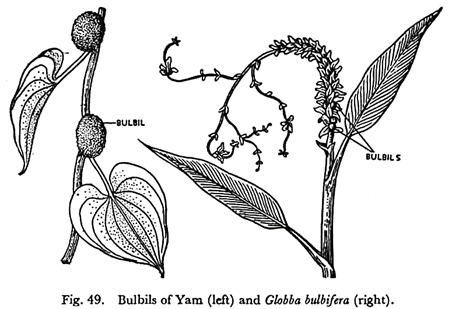In this article we will discuss about:- 1. Definition of the Bud 2. Types of the Buds 3. Protection 4. Modification.
Definition of the Bud:
The bud is a condensed rudimentary shoot. It is a compact body having an axis with a delicate growing point, nodes and very short unexpanded internodes and closely crowded young leaves (Fig. 47).
The plumule is the first bud of the plant and the cabbage is a large bud. A good idea of a bud can be had by cutting the cabbage lengthwise when the growing point, short internodes and young leaves from nodes arranged acropetally, will be clearly seen.
Types of the Buds:
Buds are of two types, according to their position:
i. Apical on terminal buds are present at the apex of the stem and the branches. They are responsible for the growth in length of the axis.
ii. Axillary or lateral buds originate from the axils of the leaves. Lateral buds usually grow into branches. Normally one bud develops from the axil of a leaf, but in some plants like Duranta (B. Mehdi), Rangoon creeper more than one bud may be present there.
If each of the axillary buds develops into a branch then the plants would naturally be many-branched ones, what is not generally noticed in plants growing around us. It is due to the fact that many axillary buds remain dormant. Dormant buds are activated if the stem is injured. After the pruning of the branches quite a large number of new buds are found to come out. Some of them are activated dormant buds.
If buds arise from any position other than the normal ones, i.e. apex and axil of the leaf, they are called adventitious. Adventitious buds may develop from the stem, roots and even leaves. When the upper part of a stem is cut off, quite a good number of buds come out spontaneously from the injured part without any order. Some of them are dormant buds no doubt, but many of them are adventitious.
Buds developing from the roots of sweet potato and Dahlia or from the leaf of Bryophyllum (B. Patharkuchi) are also adventitious ones (Fig. 48). Buds which develop into branches with leaves are the leaf buds, and those which open out to form flowers are flower-buds. Here we are discussing about the leaf buds.
Protection of the Bud:
Nature has provided suitable devices for the protection of the buds against external injuries and adverse climatic conditions. Many of them have scaly leaves, the so-called bud scales, to protect them, as in banyan, India rubber, etc. The majority of the buds of the tropical plants are naked, i.e. have no covering scales.
Leaf- bases often act as sheaths to protect them. To prevent the loss of moisture many buds have dense hairy coating or secretions of wax and resinous matters, as in Zizyphus (B. Kul). The leaves of the bud may remain rolled or folded in order to secure protection from the sun and the rain. In cold countries buds formed in the late season remain dormant over the winter to open out in the next spring.
Modification of the Bud:
Normally the axillary buds, if active, develop into branches. In Yam (B. Chupri aloo or Kham aloo) a mere or less round fleshy body is found at the axil of the leaf (Fig. 49) which, in course of time, gets detached from the mother plant and develops into new plant.
The body is swollen due to accumulating of food matters. This is called bulbil is a modification of the bud. In Globba bulbifera many bulbils are formed for reproductive purposes (fig 49).


